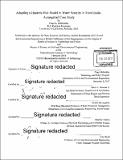Adapting a hazards-risk model to water scarcity in rural India : Aurangabad case study
Author(s)
Midstokke, Paige K
DownloadFull printable version (22.57Mb)
Other Contributors
Technology and Policy Program.
Advisor
James L. Wescoat Jr.
Terms of use
Metadata
Show full item recordAbstract
The objective of this project is to improve the responsiveness of District Planning to rural water scarcity in India. Through engagements with the Groundwater Survey Development Agency, and Maharashtra State Government Water Supply and Sanitation Department, we selected Aurangabad District to conduct field visits and develop a model that can spatially represent risk of villages to water scarcity. Within Aurangabad District, Vaijapur block was selected as a case study due to its drought effects and high water tanker usage in the past five years. This thesis develops a disaster risk metric for water scarcity, using an analysis of potential hazards, socioeconomic vulnerability, and policy responses to assign a "disaster risk score" to each village. Risk is seen as a function of hazard, vulnerability, and government capacity, so all three factors of risk are addressed. Villages are assigned a risk score in Vaijapur block of Aurangabad District By providing a risk score a season in advance of drought, planners are able to select an alternative capacity measures rather than the quickest tanker option. The aim of this research is to assist district governments in Maharashtra state in predicting, between one season to two years in advance, the risk of villages to drinking water scarcity in order to respond before incurring a drinking water crisis. Secondly, this model is used to prioritize infrastructure projects over the coming two years in order to best use limited financial resources to alleviate the burden of water scarcity at the village level. This research could ultimately be integrated into the existing state website for statewide planning and allocation of resources.
Description
Thesis: S.M. in Technology and Policy, Massachusetts Institute of Technology, School of Engineering, Institute for Data, Systems, and Society, Technology and Policy Program, 2018. Thesis: S.M., Massachusetts Institute of Technology, Department of Civil and Environmental Engineering, 2018. Cataloged from PDF version of thesis. Includes bibliographical references (pages 108-119).
Date issued
2018Department
Massachusetts Institute of Technology. Department of Civil and Environmental Engineering; Massachusetts Institute of Technology. Engineering Systems Division; Massachusetts Institute of Technology. Institute for Data, Systems, and Society; Technology and Policy ProgramPublisher
Massachusetts Institute of Technology
Keywords
Institute for Data, Systems, and Society., Civil and Environmental Engineering., Engineering Systems Division., Technology and Policy Program.